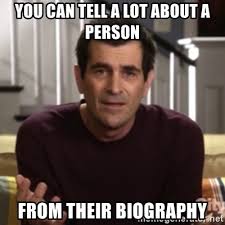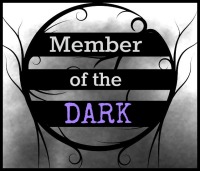
Yahoo Image Search
Sticking with the character biography topic, we’re going to look into a few tips for those who want to use this trick. I’m sure this isn’t for everyone. It’s a big plotter/planner tool alongside outlines and summaries. You can also go a little too far with a character biography, which isn’t always a bad thing. It all depends on how you use the information that you’ve carefully crafted.
- There aren’t any rules about character biographies aside from them having to be about the character. Every author has their own method and style. Some can be blocks of paragraphs while others are full essays. You might just outline the character in a sensible chart to avoid extraneous words. As long as you are happy with what you have created and can use it as a guide, you’ve done the right thing.
- While it’s fun to reveal these treats to your audience down the road or implement everything into the book, character bios are really for the author. They exist to give you a sense of your cast. Not only what they look like, but how they act, what they carry, and where they want to go. This helps you when you’re writing because now you have an established path for the characters. You can focus more on the overall plot and setting since the characters are clearer in your mind.
- Character biographies can help you pick out traits that you repeat too often. In the middle of writing, you might not realize that 90% of your characters are brunettes because the descriptions are spread out. Those that don’t fall into the main attribute might have avoided it because you described them near another, so you could see that problem before it occurred. It isn’t only physical traits, but personalities and histories may be repetitive, so biographies can help you develop a variety.
- Subplots can be born from these biographies. When designing the history and goals of a character, you will see possibilities for personal quests that run alongside the main one. Perhaps they want to find a specific item or are trying to escape their old life. It gives them more depth and an existence outside of ‘follow the main plot’. Think about your own life and how you have your main job then you have either hobbies, side jobs, or extra interests. You aren’t a one focus pony and character biographies can make sure that your characters aren’t either.
- Relationships can be clarified and shown how they will evolve as you create more of the biographies. You may find that some characters share goals or have similarities in their past. This creates bonds of friendship and a reason why they will get along during the story. On the other side, you can see why characters will hate each other, so rivalries can be born. For example, two characters may be going after the same goal, which only one can achieve. They may be hero/villain or hero/hero, which changes the dynamic to something more dramatic.
- Don’t be afraid to change up your biographies. These aren’t etched in stone, so you can change them as you write along. Just like outlines, things become partially fluid once the real writing begins. This is more to give you a general direction.
- You don’t have to use everything that you come up with in your character biographies. These are born from brainstorming, which means you may have thrown more in there than you need. You may think this is a bad thing, but it’s easier to whittle away at all of the information than to be moving along and find that you’re missing a piece. Parts that you might leave behind are stories of the past, hobbies, and anything else that doesn’t have a big impact on the story. You need these things to color your character and give them more depth, but you can go so far that scenes are practically drowning in unnecessary information. What can you do with the unused material? Fun things to share with the audience down the road. People love behind-the-scenes stuff.





Reblogged this on Chris The Story Reading Ape's Blog and commented:
Another great article from Charles 👍
LikeLike
Thanks for the reblog.
LikeLiked by 1 person
Welcome, Charles 👍😃
LikeLike
These are great tips! I wrote a bunch of likes and dislikes and goals for some characters that I have yet to use. But its nice to know the information is there. It keeps me anchored in regard to who the characters are. Also I totally agree that writing these helps the author to gauge for a lack of character variety..
LikeLike
Anchored is a great word to use here.
LikeLike
Great tips, Charles. I think the bio would avoid trouble later when figuring out how a character will react to a certain situation. Thanks, Charles.
LikeLike
Thanks. It definitely helps with keeping characters straight. Even if you make the bios as you go along.
LikeLiked by 1 person
I like this post. I’ve never gone this far before, but you give some good reasons to write it all down.
LikeLike
Thanks. Glad you enjoyed it.
LikeLiked by 1 person
Reblogged this on Author Don Massenzio and commented:
Check out this great post from Charles Yallowitz via his Legends of Windemere blog with 7 Tips to Writing Character Biographies
LikeLike
Thanks for sharing.
LikeLiked by 1 person
My pleasure. Great post.
LikeLike
One of my friends had a favorite gaming system (Fantasy Hero/Champions) and she made her fiction characters as if they were game characters. She liked that the system makes you choose disadvantages and limitations in addition to powers and abilities. At one point, she even used the gaming system to carry out a combat, because she wasn’t confident she could portray that. One of the characters was seriously injured and lost the use of an arm. She decided to incorporate that into the character permanently.
I’m not sure I would have gone that far!
LikeLike
I’ve used game systems to test out characters before. The combat systems to try out abilities too. Never included the damage in their story though. Might work if it’s unique and gives them depth.
LikeLiked by 1 person
Reblogged this on Plaisted Publishing and commented:
This is an excellent article and well worth the read. Thank you, Charles.
LikeLike
Thanks for sharing.
LikeLiked by 1 person
Welcome. You write really great articles 🙂
LikeLiked by 1 person